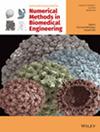Investigation of the Pressure Drop in Arterial Models With Stenoses Using Numerical and Experimental In Vitro Approaches: Effect of Elasticity
Abstract
An experimental and numerical investigation of the blood flow across the stenosis embedded in the elastic artery had been carried out within a framework of a project aimed at the development of the decision support system for the diagnostics of stable coronary artery disease, using a novel hybrid physics-informed machine learning (ML) and computational fluid dynamics (CFD) approach. Integration of CFD equations into a ML framework requires the development and validation of a CFD model optimized for this specific task. The values of empirical coefficients required for the implementation of the CFD component of the project were obtained by collecting experimental data on a pressure drop in elastic arterial models with stenoses in the physiologically relevant range of flow conditions, and the results were used for the validation of the numerical solver. Analysis of the experimental data also demonstrated a strong impact of the vessels' elasticity on the pressure drop across a stenosis, as well as a substantial role of the time-dependent (pulsative) flow parameters. It has been shown that fine-tuning of the values of the viscous and turbulent resistance coefficients to account for the elasticity of the vessels surrounding the stenosis can substantially improve the accuracy of the pressure drop prediction in the intermediate lesions, specifically relevant for clinical applications.


 求助内容:
求助内容: 应助结果提醒方式:
应助结果提醒方式:


